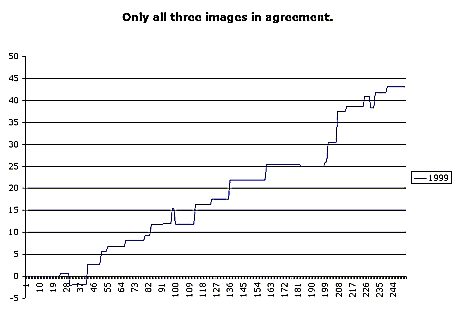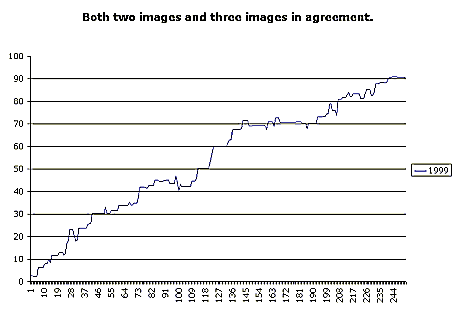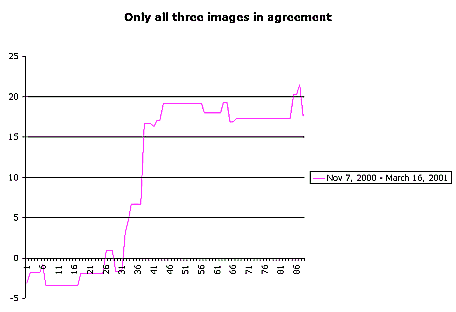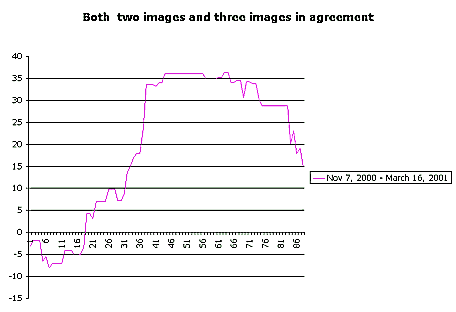|
NASA
and other Astronomer-Photographers often use an image
enhancement technique of stacking images taken at different
times. Through this process they can increase the resolution
beyond that of the original camera. A single photo may show a
number of dim specks of light, but when stacked the dim stars
are enhanced and "fake" stars that may be dust, gas or
reflections tend to cancel out. We too can, in a
sense, take photos of the stock market. When we do this,
our forecasts appear similar to dim stars. We are now working
with three such "photos". We use numerical
techniques rather than graphic, but the results are similar.
1999 was a strong up year. Looking at the 1999 data [that was not
used to train the program] we look at what happened when all
three images were in agreement. (All graphs below use a 2x
dynamic fund factor.)

The
above graph shows a very consistent equity gain when all
three signals agreed.

The
above graph shows what would have happened in 1999 with both two
signals and three signals agreed. The % correct was not as
high here but the return doubled. Now lets look at the
recent time frame from Nov. 7, 2000 to March 16, 2001below.

We
can see that the program is still working fine as long as all
three signals agree. So let's see what happens when we combine
two signals of agreement with the three signals, see below.

Under
these extremely negative conditions two signals in agreement is
not enough! A quick look at the table below provides us
with even more assurance.
| Dates |
1999 |
Nov-Mar,2000 |
1999 |
Nov-Mar,2000 |
| |
%
Correct |
%
Correct |
%
gain/loss |
%
gain/loss |
| three
agree |
84% |
67% |
43.1% |
17.5% |
| two
agree |
64% |
50% |
47.7% |
-2.4% |
| one
signal |
55% |
50% |
34.1% |
-6.4% |
It
becomes very clear looking at both the % correct and the
gain/loss that the reliability increases as we move from one
signal to two signals and on to three. We have gone into this a
lot further examining the up signals verses the down signals.
| |
1999 |
Nov
2000-Mar 2001 |
| Buy
signals: gain /loss |
93.2% |
-9.3% |
| Sell
signals: gain/loss |
31.5% |
18.0% |
These
numbers would be more even, but with 1999 being a year of excess
up, and Nov-March 2001 reflecting excess down, the results skew.
The skewing comes from what happens after the markets close. During
a strong up period like 1999 the after-close reports are mostly
good, and that turns weak buy signals into strong buy signals.
Weak sell signals would become buys, but since the program was
trained over mostly up markets weak sell signals are somewhat
compensated for, see below.
| |
1999 |
Nov
2000-Mar 2001 |
| Buy
signals |
.87% |
-.23% |
| Sell
signals |
.54% |
.69% |
The
above figures show the average % per trade gained or lost. You
can see by this that "buy" signals during bear markets
are subject to the greatest risk. In extremely negative markets
like this the weaker "buy" signals are subject to the
overnight influences of negative reports from companies and
brokerage houses. The answer...In extreme negative conditions
trade in only the strongest signals until conditions
improve. Meanwhile we are busy building new
"snapshots"
|
